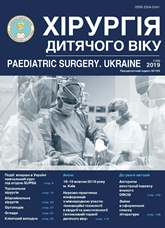Laparoscopic treatment of splenic cysts in children
DOI:
https://doi.org/10.15574/PS.2019.63.36Keywords:
splenic cyst, children, laparoscopic treatment, resultsAbstract
With the development of minimally invasive surgery, surgical treatment of splenic cysts (SC) with laparoscopy has become quite relevant.
Aim of study: to analysis the effectiveness of laparoscopic treatment of splenic cysts in children.
Materials and methods. We have experience in the surgical treatment of 164 patients with SC in children aged 6 months to 18 years. Clinical and laboratory data, ultrasound, CT or MRI were used for diagnosis. With the help new diagnostic methods, it was possible to detect SC in the early stage. We followed the organo-saving principle during surgical treatment of SC in 112 children; various variants of open organ-saving operations on the spleen have been performed. In 52 patients SC were resected by laparoscopy.
Results. Depending on localization, size, correlation with the architecture of major vessels and the variant of parenchyma lesions laparoscopic cystectomy (n=20), fenestration of the cyst wall with capitonnage (n=14) and partial resection of the spleen (n=18) were performed. In five patients, a relapse of the cyst was observed in long term. These were the children after fenestration of the cyst without capitonnage (n=2) and after fenestration of the cyst with its filling with the tissue of the greater omentum (n=3). The recurrence of the SC was corrected by an open operation. Seven children in the postoperative period retained the minimal residual cavity of the cyst, which automatically healed (scared) in the dynamics follow up during 1-2 years.
Conclusions. The partial resection of the spleen, taking into account its segmental blood supply, is a rational method of treatment of SC, which radically eliminates pathology and retains all important functions of the spleen. Laparoscopic correction of SC in children has limited indications because of organsaving approach in the treatment of this pathology. The individual selection of patients depend on the localization, size, ratio to the architecture of the major vessels and the variant of lesions of the parenchyma of the spleen on the basis of radiological methods of diagnosis and acquired experience of profile clinics.
References
Accinni A, Bertocchini A, Madafferi S, Natali G, Inserra A. (2016). Ultrasound-guided percutaneous sclerosis of congenital splenic cysts using ethyl-alcohol 96% and minocycline hydrochloride 10%: A pediatric series. J Pediatr Surg. 51(9):1480–1484. https://doi.org/10.1016/j.jpedsurg.2016.05.005; PMid:27320839
Adas G, Karatepe O, Altiok M, Battal M, Bender O, Ozcan D, Karahan S. (2009). Diagnostic problems with parasitic and non-parasitic splenic cysts. BMC Surgery. 9:9. doi 10.1186/1471-2482-9-9. https://doi.org/10.1186/1471-2482-9-9; PMid:19476658 PMCid:PMC2701920
Bas G, Alimoglu O, Sahin M, Uranues S. (2009). Laparoscopic partial splenic resection in hydatid disease. European Surgery – ACA Acta Chirurgica Austriaca. 41/42: 90–93. https://doi.org/10.1007/s10353-009-0458-9
Dan D, Bascombe N, Harnanan D, Hariharan S, Naraynsingh V. (2010). Laparoscopic management of a massive splenic cyst. Asian J Surg. 33(2):103–106. https://doi.org/10.1016/S1015-9584(10)60018-8
Delforge X, Chaussy Y, Borrego P, Abbo O, Sauvat F, Ballouhey Q, Irtan S, Arnaud A, Panait N, Rodesch G, Steyaert H, Schneider A, Dubois R, Mesureur S, Haraux E, Buisson P. (2017). Management of nonparasitic splenic cysts in children: A French multicenter review of 100 cases. J. Pediatr Surg. 52(9):1465–1470. https://doi.org/10.1016/j.jpedsurg.2017.01.054; PMid:28185630
Garza-Serna U, Ovalle-Chao C, Martinez D, Flores-Villalba E, Diaz-Elizondo JA, Garza-Luna U de J. (2017). Laparoscopic partial splenectomy for congenital splenic cysts in a pediatric patient: case report and review of literature. Intern J Surg Case. Rep.33:44–47. https://doi.org/10.1016/j.ijscr.2017.02.013; PMid:28267665 PMCid:PMC5338892
Geraghty M, Khan IZ, Conlon KC. (2009). Large primary splenic cyst: A laparoscopic technique. J Min Access Surg. 5:14–16. https://doi.org/10.4103/0972-9941.51315; PMid:19547686 PMCid:PMC2699073
Hassoun J, Ortega G, Burkhalter LS, Josephs S, Qureshi FG. (2018). Management of nonparasitic splenic cysts in children. J Surg Research. 223:142–148. https://doi.org/10.1016/j.jss.2017.09.036; PMid:29433866
Ingle SB, Hinge CR, Patrike S. (2014). Epithelial cysts of the spleen: A minireview. World J Gastroenterol. 20 (38):13899–13903. https://doi.org/10.3748/wjg.v20.i38.13899; PMid:25320525 PMCid:PMC4194571
Khan Z, Chetty R. (2016). A review of the cysts of the spleen. Diagnostic Histopathology. 22(12):479–484. https://doi.org/10.1016/j.mpdhp.2016.10.002
Lopez JJ, Lodwick DL, Cooper JN, Hogan M, King D, Minneci PC. (2017). Sclerotherapy for splenic cysts in children. J Surg Research. 219:1–4. https://doi.org/10.1016/j.jss.2017.05.029; PMid:29078866
Sinha CK, Agrawala M. (2011). Nonparasitic splenic cysts in children: Current status. The Surgeon. 9(1):49–53. https://doi.org/10.1016/j.surge.2010.08.005; PMid:21195332
Sinwar PD. (2014). Overwhelming post splenectomy infection syndrome – review study. Int J Surg. 12:1314–1316. https://doi.org/10.1016/j.ijsu.2014.11.005; PMid:25463041
Szczepanik AB, Meissner AJ. (2009). Partial splenectomy in the management of nonparasitic splenic cysts. World J Surg. 33:852–856. https://doi.org/10.1007/s00268-008-9868-2; PMid:19172349
Zvizdić Z, Karavdić K. (2013). Spleen-preserving surgery in treatment of large mesothelial splenic cyst in children – a case report and review of the literature. Bosn J Basic Med Sci. 13(2):126–128. https://doi.org/10.17305/bjbms.2013.2395; PMid:23725510 PMCid:PMC4333933
Downloads
Issue
Section
License
The policy of the Journal “PAEDIATRIC SURGERY. UKRAINE” is compatible with the vast majority of funders' of open access and self-archiving policies. The journal provides immediate open access route being convinced that everyone – not only scientists - can benefit from research results, and publishes articles exclusively under open access distribution, with a Creative Commons Attribution-Noncommercial 4.0 international license(СС BY-NC).
Authors transfer the copyright to the Journal “PAEDIATRIC SURGERY.UKRAINE” when the manuscript is accepted for publication. Authors declare that this manuscript has not been published nor is under simultaneous consideration for publication elsewhere. After publication, the articles become freely available on-line to the public.
Readers have the right to use, distribute, and reproduce articles in any medium, provided the articles and the journal are properly cited.
The use of published materials for commercial purposes is strongly prohibited.

